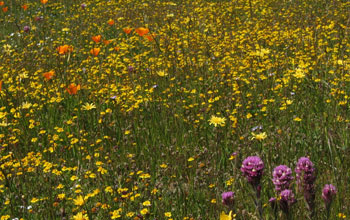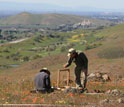News Release 12-083
Ecosystem Effects of Biodiversity Loss Rival Climate Change and Pollution
First comprehensive effort to compare biodiversity loss to other human-caused environmental changes

Native wildflowers still dominate this prairie-like California serpentine grassland.
May 2, 2012
This material is available primarily for archival purposes. Telephone numbers or other contact information may be out of date; please see current contact information at media contacts.
Loss of biodiversity appears to affect ecosystems as much as climate change, pollution and other major forms of environmental stress, according to results of a new study by an international research team.
The study is the first comprehensive effort to directly compare the effects of biological diversity loss to the anticipated effects of a host of other human-caused environmental changes.
The results, published in this week's issue of the journal Nature, highlight the need for stronger local, national and international efforts to protect biodiversity and the benefits it provides, according to the researchers, who are based at nine institutions in the United States, Canada and Sweden.
"This analysis establishes that reduced biodiversity affects ecosystems at levels comparable to those of global warming and air pollution," said Henry Gholz, program director in the National Science Foundation's Division of Environmental Biology, which funded the research directly and through the National Center for Ecological Analysis and Synthesis.
"Some people have assumed that biodiversity effects are relatively minor compared to other environmental stressors," said biologist David Hooper of Western Washington University, the lead author of the paper.
"Our results show that future loss of species has the potential to reduce plant production just as much as global warming and pollution."
Studies over the last two decades demonstrated that more biologically diverse ecosystems are more productive.
As a result, there has been growing concern that the very high rates of modern extinctions--due to habitat loss, overharvesting and other human-caused environmental changes--could reduce nature's ability to provide goods and services such as food, clean water and a stable climate.
Until now, it's been unclear how biodiversity losses stack up against other human-caused environmental changes that affect ecosystem health and productivity.
"Loss of biological diversity due to species extinctions is going to have major effects on our planet, and we need to prepare ourselves to deal with them," said ecologist Bradley Cardinale of the University of Michigan, one of the paper's co-authors. "These extinctions may well rank as one of the top five drivers of global change."
In the study, Hooper, Cardinale and colleagues combined data from a large number of published studies to compare how various global environmental stressors affect two processes important in ecosystems: plant growth and the decomposition of dead plants by bacteria and fungi.
The study involved the construction of a database drawn from 192 peer-reviewed publications about experiments that manipulated species richness and examined their effect on ecosystem processes.
This global synthesis found that in areas where local species loss during this century falls within the lower range of projections (losses of 1 to 20 percent of plant species), negligible effects on ecosystem plant growth will result, and changes in species richness will rank low relative to the effects projected for other environmental changes.
In ecosystems where species losses fall within intermediate projections of 21 to 40 percent of species, however, species loss is expected to reduce plant growth by 5 to 10 percent.
The effect is comparable to the expected effects of climate warming and increased ultraviolet radiation due to stratospheric ozone loss.
At higher levels of extinction (41 to 60 percent of species), the effects of species loss ranked with those of many other major drivers of environmental change, such as ozone pollution, acid deposition on forests and nutrient pollution.
"Within the range of expected species losses, we saw average declines in plant growth that were as large as changes in experiments simulating several other major environmental changes caused by humans," Hooper said.
"Several of us working on this study were surprised by the comparative strength of those effects."
The strength of the observed biodiversity effects suggests that policymakers searching for solutions to other pressing environmental problems should be aware of potential adverse effects on biodiversity as well.
Still to be determined is how diversity loss and other large-scale environmental changes will interact to alter ecosystems.
"The biggest challenge looking forward is to predict the combined effects of these environmental challenges to natural ecosystems and to society," said J. Emmett Duffy of the Virginia Institute of Marine Science, a co-author of the paper.
Authors of the paper, in addition to Hooper, Cardinale and Duffy, are E. Carol Adair of the University of Vermont and the National Center for Ecological Analysis and Synthesis; Jarrett Byrnes of the National Center for Ecological Analysis and Synthesis; Bruce Hungate of Northern Arizona University; Kristen Matulich of University of California, Irvine; Andrew Gonzales of McGill University; Lars Gamfeldt of the University of Gothenburg; and Mary O'Connor of the University of British Columbia and the National Center for Ecological Analysis and Synthesis.
-NSF-
-
Serpentine grasslands are home to the endangered Bay Checkerspot butterfly.
Credit and Larger Version -
Scientist David Hooper of Western Washington University conducting grassland research.
Credit and Larger Version -
Biologists David Hooper and Leslie Gonzalez measure plant diversity and productivity.
Credit and Larger Version -
Leslie Gonzalez samples plant diversity at Coyote Ridge, Calif.; pollution threatens this site.
Credit and Larger Version -
Researchers Daniel Slakey and Anton Clifford in a serpentine grassland near San Jose, Calif.
Credit and Larger Version
Media Contacts
Cheryl Dybas, NSF, (703) 292-7734, email: cdybas@nsf.gov
Jim Erickson, University of Michigan, (734) 647-1842, email: ericksn@umich.edu
The U.S. National Science Foundation propels the nation forward by advancing fundamental research in all fields of science and engineering. NSF supports research and people by providing facilities, instruments and funding to support their ingenuity and sustain the U.S. as a global leader in research and innovation. With a fiscal year 2023 budget of $9.5 billion, NSF funds reach all 50 states through grants to nearly 2,000 colleges, universities and institutions. Each year, NSF receives more than 40,000 competitive proposals and makes about 11,000 new awards. Those awards include support for cooperative research with industry, Arctic and Antarctic research and operations, and U.S. participation in international scientific efforts.
Connect with us online
NSF website: nsf.gov
NSF News: nsf.gov/news
For News Media: nsf.gov/news/newsroom
Statistics: nsf.gov/statistics/
Awards database: nsf.gov/awardsearch/
Follow us on social
Twitter: twitter.com/NSF
Facebook: facebook.com/US.NSF
Instagram: instagram.com/nsfgov







